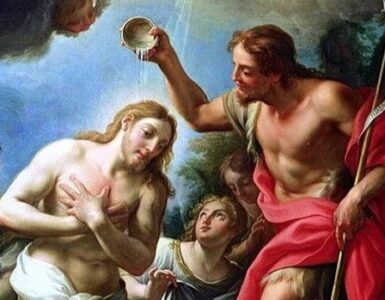Dust and ashes are distinguishing marks of Lent’s opening days. It is no accident that the Ash Wednesday service is one of the most popular Lenten observances, even for non-Catholics. Even for the nominally religious, ashes on the forehead contain a certain symbolic appeal, speaking not only of our origins but of our end. For, as ashes are placed upon our heads, we hear the words, “Remember that you are dust, and to dust you shall return.”
But Ash Wednesday is only the first step. As we go deeper into Lent, the liturgy further sharpens this focus on our ultimate destination. On the Sunday following Ash Wednesday, the First Reading presents the creation account, which takes us even further back to our dusty roots in the Garden of Eden. Here we read how “the Lord God formed the man out of the dust of the ground and blew into his nostrils the breath of life, and the man became a living being” (Gen. 2:7). We were made from dust, and with the Fall we descend back into dust. We are reminded of this fact of life (and death) in the Ash Wednesday blessing over the ashes, when we “acknowledge we are but ashes and shall return to dust.”
But the ashes do more than recall our own fall: they should remind us that our transgression has turned the entire cosmos to chaos. We have brought down not just ourselves but all of creation with us. Not long after Adam and Eve’s creation, “out of the ground the Lord God made grow every tree that was delightful to look at and good for food, with the tree of life in the middle of the garden” (Gen. 2:9). But with Adam’s sin (the name Adam means “earth” or “ground”), all of the ground is cursed (Gen. 3:17), as well as the vegetation that comes from it. It is fitting, then, that Ash Wednesday’s ashes are “made from the olive branches or branches of other trees that were blessed the previous year.” Earth’s trees and plants that were once alive are themselves reduced to dust, as an anticipation of our own death.
So,
Ash Wednesday and Lent, especially its early weeks, remind us (can we forget?)
that we humans (human, like Adam, means “earthly”) are given life from the ground by God’s will,
but that we shall return to the ground by the free choice of our will. Thus
far, not a happy story. But at least there is nowhere to go but up!
But listen to the first words on the Church’s
Lenten lips. The entrance antiphon for Ash Wednesday declares, “You are
merciful to all, O Lord, and despise nothing that you have made. You overlook
people’s sins, to bring them to repentance, and you spare them, for you are the
Lord our God” (Wis. 11:24, 25, 26). True, we have reduced ourselves to dust,
but this is not where the story ends (how sad for those who believe it is!).
God’s mercy, as Lent’s first proclamation says, overlooks the chasm of our sins
and restores us to life. As the psalmist puts it: “He raises the needy from the
dust, lifts the poor from the ash
heap, Seats them with princes, the princes of the people”
(Ps. 113:7-8). If creation raised us from the dust, and original sin returned
us to dust, Lent and Easter will raise us up once more and bring us across that
bridge that separates us from God.
But passing over has never been an easy task. Moses found the work
exhausting (“If this is the way you will deal with me,” he complained to God,
“then please do me the favor of killing me at once, so that I need no longer
face my distress!” [Num. 11:15]). Joshua, who led the people into the promised
land after Moses’ death, also knew the difficulty involved in passing over.
Recall how he and Caleb encouraged the frightened people to enter the Promised Land: “If the LORD is pleased with us, he will bring us in to this land and give it to us, a land which flows with milk and honey. Only do not rebel against the LORD! You need not be afraid of the people of the land, for they are but food for us!” (Num. 14:8–9). Similarly, both Elijah and Ruth passed over to new life only by great effort and toil.
Consider the anguished pleas of Elisha before Elijah, and Orpah and Ruth before Naomi, prior to their respective passovers (see 2 Kings 2; Ruth 1). Anyone who has ever prayed the Stations of the Cross knows, too, that the same exertions (and more!) accompanied Jesus’ Passover (perhaps this is why both Moses and Elijah appear with Jesus at His Transfiguration — to give Him encouragement). The same challenge, too, opens before us in Lent.
Conclusion
The Church likens the Lenten season to climbing “the Holy mountain of Easter,” ( Paschalis Sollemnitatis, no. 6). On the far side of the paschal bridge, from the vantage point of the Easter victory, the Church looks back on Christ’s (and our) work and calls it a “stupendous combat,”* where death and life fought a bitter battle. It’s a battle worth fighting, and a battle we can win.
But part of our success sees the goal, the end, the purpose: the Paschal Mystery, where we work with Jesus to span heaven and earth. And unless there is a bridge in our sights on Ash Wednesday, our journey through Lent risks ending where we began: right here in the fallen and dusty world of sin. It is a good thing we have a captain, coworkers, and tools necessary to win to victory.
✠
* Editor’s note: “Death and life have contended in that combat stupendous.” From the Easter Sequence, Victimae Paschali laudes, sung before the Gospel acclamation on Easter Sunday and (as an option) throughout the Easter Octave. See Lectionary for Mass (New Jersey: Catholic Book Publishing, 1998), vol. I, 357.
This article is adapted from a chapter in Christopher Carsten’s latest book, A Devotional Journey into the Easter Mystery | How Prayerful Participation in the Paschal Mystery Brings Life, Joy, and Happiness. It is available as an ebook or paperback from Sophia Institute Press.
Photo by Ahna Ziegler on Unsplash














